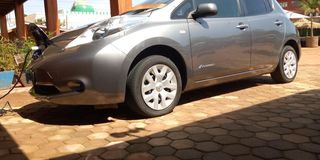Prime
The Nissan Leaf comes with less maintenance

One of the many amazing features of the Nissan Leaf is that it has significantly less parts than a non-electric vehicle, which makes it much easier and more cost-effective to get regular maintenance. PHOTO | COURTESY
Driving a fully electric Nissan Leaf 2016 model through the hilly suburb of Naguru, Kampala, was quite an adventure. Cars closer to it are mostly hybrid, use fuel, and at high speeds, switch to electric mode.
What is likable about the Leaf is the mileage it gives when different functions are switched on and off. For instance, with the air conditioner switched on, I had up to 56 kilometres to cover. When I switched it off, the dashboard showed I could go 63 kilometres. It has no engine, gearbox, radiator or driving shaft, and no component uses oil or lubricants. It only has two mortars under the bonnet at the front and a fully computerised system.
While running, the dashboard indicates D-eco, meaning it was switching to economy mode. If you change the functionality from the gently turned gear lever, the D-eco system goes off and the car goes into non-economy mode and is faster. It is a quiet smooth drive with zero emissions. The only noise you hear is from the environment.
While driving, the dashboard will show how much power you are using as you accelerate. It also shows how much power you have left, the mileage it can cover and battery temperature. Under normal conditions, the battery temperature gauge bars, similar to those of a button-operated mobile phone, are blue. When the battery heats up, the temperature gauge bars turn red, a sign that there is something wrong. Usually, this happens because of an overcharge that is normally caused by electrical faults, which also rarely happens in most electric cars.
Performance
The maximum speed of the Nissan Leaf is greater than that of the average car, say Japanese cars whose maximum speed is 180km/hr. The Leaf goes up to 290km/hr and picks speed from zero to 60km/hr in three to five seconds.
Features
Apart from the AC and sound system, the Leaf has buttons on all seats that warm up your seat, especially when it is cold. The steering can also warm up to required temperatures. It also has a provision of opening the charging ports manually, or by pressing a button on the car key. The interior is spacious, and for comfort, it is a four seater.
Charging system
According to Andrew Kananura, who has driven a number of electric cars in Europe, the charge of the Nissan Leaf and most brands from zero to 100 percent takes three to four hours using its three-pin point plug, depending on the type of charger used. There is, however, a faster charger that takes only 15 minutes and costs $400-$500 (about Shs1.44m to Shs1.8m).
As you charge, there are three bars under the windscreen that show how much battery one has. At 30 percent charged, the first bar lights blue and at 60, 90 and 100 percent full respectively, all the bars will light blue.
“These cars are zero maintenance except for the tyres. With the newer models, if anything goes wrong, a message will be sent to your phone, a configuration that can be achieved as long as one has WiFi. The dealership logs into the car, rectifies the fault and you pay for the service using a visa card. If it has an inherent problem, the dealership will email you the needed part. It is a car that can be fixed at night while you are sleeping and you wake up to a message alert about the cost,” Kananura explains.
Battery life
From the onset of buying a Nissan Leaf, you are guaranteed 10 years of good battery life. However, in countries such as New Zealand and Australia there are first, second and third generation batteries, all with the same casing.
When your battery gets old, the old battery system is replaced at a cost of approximately $3,000, (approximately Shs10m).
The battery generation pack that comes with the car gives you approximately 140 miles in one full single charge, depending on how long it has been used, but a new one gives you between 280 to 500 miles. There are vehicle brands that give you 1,000 miles of single charge. To fill up a car electric battery is equivalent to Shs14,200, which is approximately 20 units of power.
With the current cost of fuel, with a litre currently averaging at Shs6,000, it means the cost of two litres of fuel is almost equivalent to a fully charged battery of a Nissan Leaf, without considering the cost of other car lubricants such as engine oil.
Consider electric cars soon, as the way to go. You are better off having a machine that uses a product (hydroelectric power) that is locally produced and you are never cut off at any point than relying on imported fuel.
“The only problem I see is with mileage ranges. The newer the car, the longer the mileage range. The disadvantage to this is that if you want long ranges, you will pay more money. For example, for long range mileage to places such as Kabale in western Uganda, you need an expensive car with longer battery life,” Kananura explains, adding that longer range mileage electric cars cost between $100,000, which is approximately Shs360m or more.
The Nissan Leaf also has better ground clearance than most saloons. Because it does not have anything heavy at the front, it handles potholes better than one with a heavy engine or gearbox. This does not compromise stability because the even distribution of the battery on the car floor makes it more stable.




